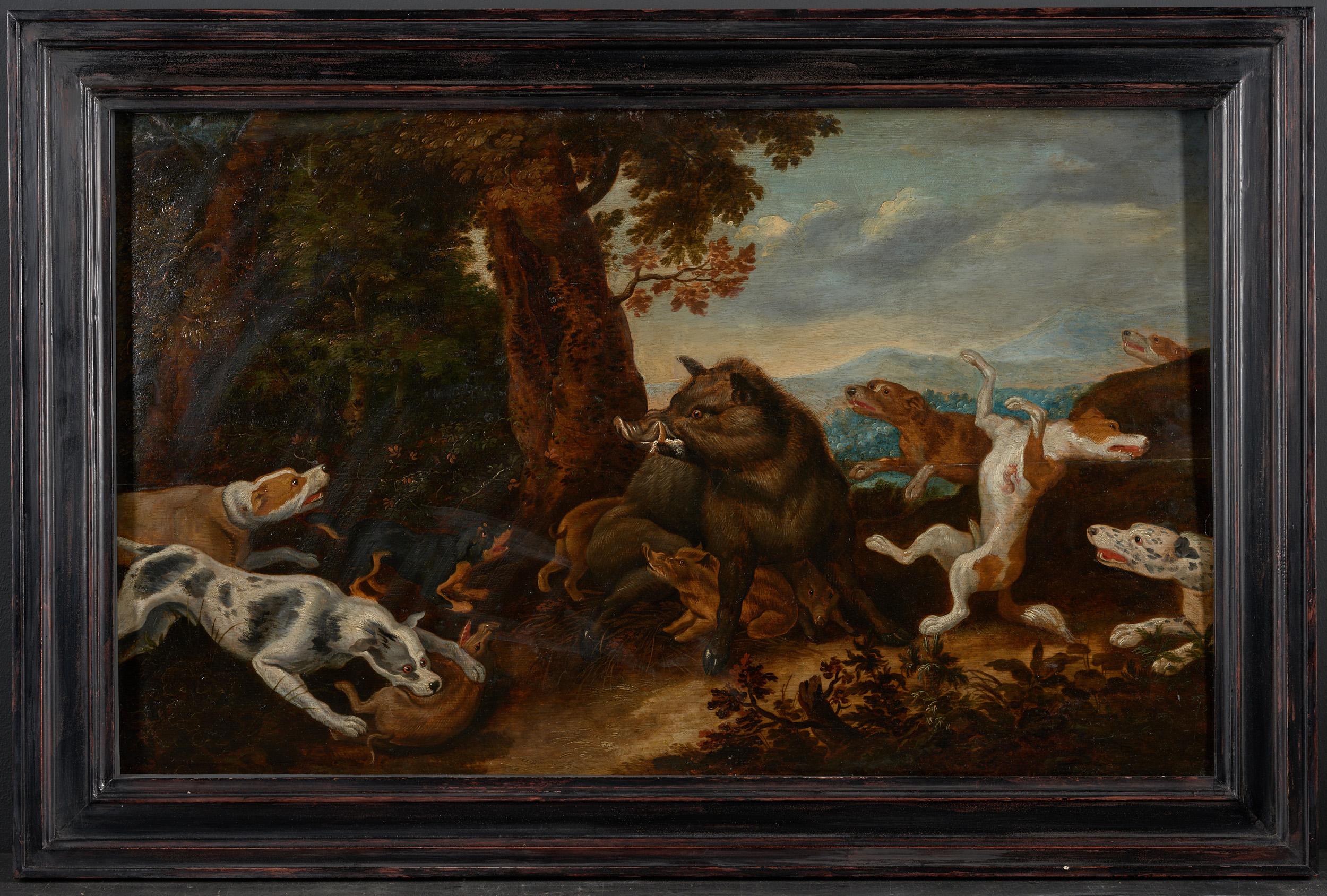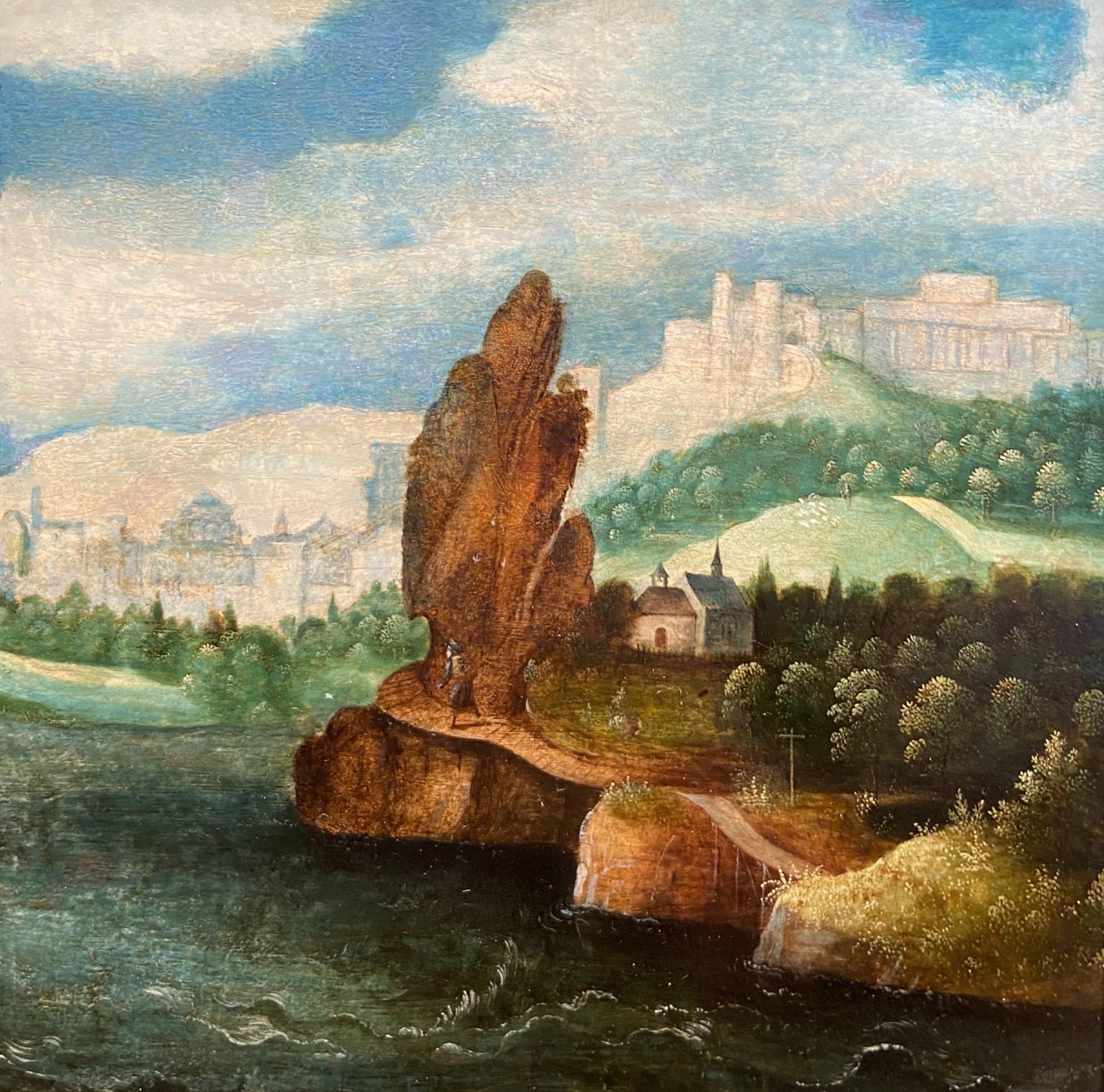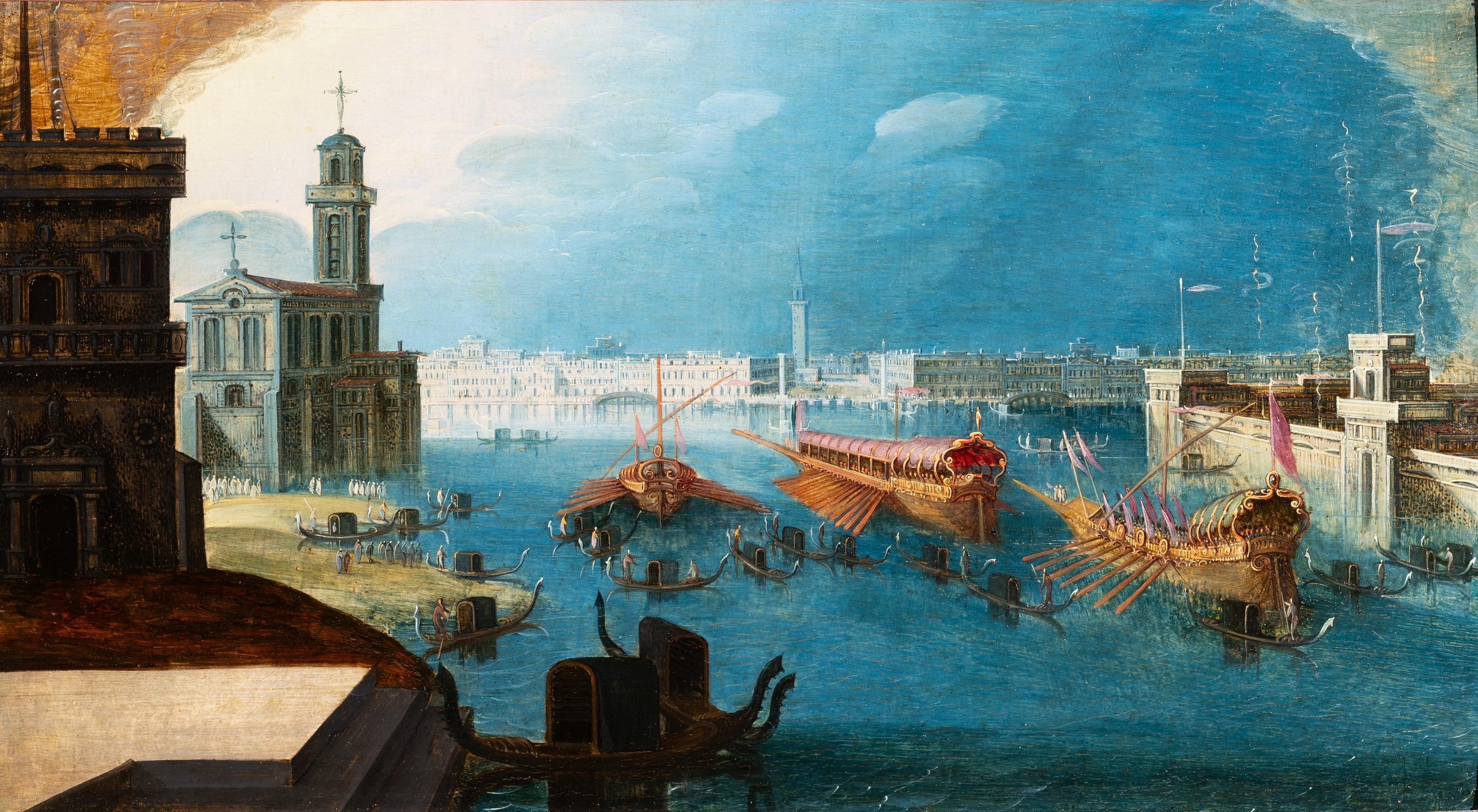Items Similar to Shepherd with his Herd at Dusk
Want more images or videos?
Request additional images or videos from the seller
1 of 3
Shepherd with his Herd at Dusk
About the Item
Oil on oak panel
Image size: 11 1/2 inches circular diameter (29 cm)
Hand carved gilt frame
- Dimensions:Height: 11.5 in (29.21 cm)Diameter: 11.5 in (29.21 cm)
- More Editions & Sizes:11 1/2 diameterPrice: $14,570
- Medium:
- Circle Of:Roelant Savery (1578 - 1639, Flemish, Dutch)
- Period:
- Condition:
- Gallery Location:London, GB
- Reference Number:1stDibs: LU52410556572
About the Seller
5.0
Vetted Seller
These experienced sellers undergo a comprehensive evaluation by our team of in-house experts.
Established in 2007
1stDibs seller since 2014
63 sales on 1stDibs
Typical response time: 4 hours
- ShippingRetrieving quote...Ships From: London, United Kingdom
- Return PolicyA return for this item may be initiated within 14 days of delivery.
More From This SellerView All
- Landscape with Rocky VistaLocated in London, GBOil on oak panel Image size: 6 1/4 x 6 1/4 inches (15.75 x 15.75 cm) Period ebonised frame Patinir’s poetic imagination allowed him to express an idealised world, or one steeped in pathos, with profound sentiments, and always with perfect technique. The level of detail in this work is astonishing and the viewer is sure to make new discoveries every time that they gaze upon it, such as the birds diving down from the rocky form or the spindly poles that hold up the bowing bridge. Patinir's landscapes recall the background landscapes in the work of his contemporary Netherlandish painters, such as Gerard David. His magnificent rendering of light and shadows also foreshadow the great Dutch masters of the 17th century; as well does his excellent use of colour—especially his delightful range of blues and greens. Together, these traits make his works both innovative and uncommonly attractive. Here, although the scene is populated, the figures are small and the landscape assumes increasing importance. Joachim Patinir Joachim Patinir, who was born on the banks of the Meuse River, is considered the first Flemish landscape painter. His vast, highly personal landscapes are characterized by large expanses of terrain with high horizons and fantastic outcroppings of pointed rock that combine real and symbolic. He is thought to have begun his career in Bruges, where he discovered the work of Gérard David, but like David, he appears on a list of Antwerp-based masters in 1515. There, he met and befriended Albrecht Dürer, who visited the Netherlands in 1520-1521. Dürer subsequently painted his portrait and even attended his daughter’s wedding. Patinir was also friends with Quintin Massys, who painted some of the figures in his works. Their friendship was so lasting that Massys’ son, Cornelis, apprenticed with Patinir. Cornelis eventually married Patinir’s daughter, Francisca Buyts, and the elder painter became their tutor. In 1521, Patinir remarried, this time to Jeanne Nuyts. His life was quite short, and he produced relatively few paintings, notwithstanding certain mediocre works erroneously attributed to him. His fame is due primarily to his final paintings, whose masterful technique and creativity were praised by his peers. In his travelogue, Dürer called him "a good landscape painter", and Felipe de Guevara, a friend and artistic assessor to both Charles V and Philip II, mentions him in his "Commentaries on Painting" (1540) as one of the three greatest painters, alongside Rogier van der Weyden and Jan van Eyck. His work was also very successful on the art market, especially when we recall that, in 16th-century Antwerp, artists did not work on commission. Instead, they sold finished works to their clients. From the very start, Patinir’s paintings reflect the influence of Hieronymus Bosch, although they lack that master’s satirical edge. He was also influenced by Gérard David, from whom he drew his perfect execution as well as his taste for landscape. His name appears on two early works—"Saint Jerome" (Staatliche Kunsthalle, Karlsruhe) and "The Flight to Egypt" (Koninklijk Museum voor Schone Kunsten, Antwerp)—but his inscriptions on three other panels—"The Baptism of Christ" (Kunsthistorisches Museum, Vienna), "Landscape with...Category
16th Century Flemish School Landscape Paintings
MaterialsOak, Oil
- Sanctuary, Cliffs at St Just, Cornwall - newlyn schoolLocated in London, GBOil on panel, signed lower right Image size: 12 1/2 x 15 1/2 inches (32 x 39 cm) Art Deco style frame Inscribed verso "Sanctuary, St Just, Cornwall" Also with sketch by the artist a...Category
Early 20th Century Landscape Paintings
MaterialsOil, Panel
- Moonlight Scene with FishermenLocated in London, GBOil on canvas Image size: 23 1/2 x 18 1/2 inches (60 x 47 cm) Original frame This moonlit view features many of the usual features of Sebastian Pether's work: a painterly river, mountain scenery and the incorporation of classical gothic ruins in an attractive though artificial style. The ruins in the foreground and city in the background have been painstakingly depicted in meticulous detail. On the bank in the foreground, and out on the river itself, we see three night fishermen silhouetted against the calm waters. The artist has cleverly balanced the light emanating from the moon, and the reflection of this light glistening on the river surface below, to create the mysterious atmosphere of the moonlit evening. Indeed, he has skilfully employed the strong use of chiaroscuro effects of light and shade in this painting so that the eye is drawn to the full moon as it illuminates the sky. It is undeniably a work of Romanticism, a style that was popular around the beginning of the nineteenth century. The Artist Sebastian Pether was an English landscape-painter. He was the eldest son of Abraham Pether...Category
Early 19th Century Victorian Landscape Paintings
MaterialsOil, Canvas
- Pastoral Scene with FiguresLocated in London, GBOil on canvas, signed lower left Image size: 23 1/4 x 23 1/2 inches (59 x 60 cm) Hand made contemporary style frame This exciting newly discovered work by Guthrie is quite a rarity....Category
20th Century Landscape Paintings
MaterialsOil, Canvas
- The Sand Pit, 1905 Oil Painting, English Pastoral LandscapeBy Alfred Robert HaywardLocated in London, GBOil on board, signed lower left Inscribed and dated 1905 on reverse Image size: 8 1/4 x 10 1/2 inches (21 x 27 cm) Contemporary style hand made frame This is a scene of the outskirts of the village of East Ruston, found near the coast in Norfolk. The setting is a sand and gravel pit with the houses of the village just identifiable through the trees in the background. This small sand pit...Category
Early 1900s Modern Landscape Paintings
MaterialsOil, Board
- A Riverside Alley Oil Landscape 20th CenturyLocated in London, GBFrank Lewis Emanuel 1865 - 1948 A Riverside Alley, Norwich Oil on board, signed and dated '1909' bottom left Image size: 13 1/2 x 9 1/2 inches (34....Category
Early 20th Century Landscape Paintings
MaterialsBoard, Oil
You May Also Like
- Dutch School, 17th Century, Shipping in a Stiff Breeze, a City BeyondLocated in Stockholm, SEWe are delighted to present a significant piece from the Dutch School, most likely dating back to the late 17th century. This captivating painting showcases the dynamic force of nature with three ships vigorously navigating through stormy waters. The foreground is a scene of nautical struggle, as figures are depicted working intensely with the sails, steering, and bracing against the tumultuous sea. In the serene background, the silhouette of a quaint town emerges, with spires from churches and the outlines of various buildings is visible. This juxtaposition of the calm town against the chaotic foreground serves as a powerful reminder of the unpredictability of life and nature. Dominating the canvas, the sky occupies two-thirds of the painting, filled with brooding clouds that occasionally break to reveal patches of blue. The presence of birds adds a dynamic element to the otherwise ominous atmosphere. While the artist remains unknown, the work is quintessentially Dutch in its execution, with meticulous attention to detail and a profound understanding of maritime life. The painting's oval shape is quite distinctive and is complemented by a suitably antique octagonal black frame, which adds to its historical charm. This piece is a testament to the mastery of Dutch maritime painting...Category
17th Century Old Masters Landscape Paintings
MaterialsOak, Oil, Wood Panel
- Landscape with Gentleman on Horseback and Peasant Woman Receiving AlmsBy Philips WouwermanLocated in Stockholm, SEWorkshop / Circle of Philips Wouwerman (1619-1668) Landscape with Gentleman on Horseback and Peasant Woman Receiving Alms oil on oak panel 12.40 x 14.17 inches (31.5 x 36 cm) wit...Category
17th Century Old Masters Landscape Paintings
MaterialsOak, Oil, Wood Panel
- 17th C, Baroque, Hunting Scene, Wild Boar Hunt in the style of Frans SnijdersLocated in brussel, BEHunting played an essential role in the lives of princes and nobles for centuries. It was no different in the 17th century. Paintings depicting hunting scenes were hung, for example, in the hunting lodges of elites. It should be noted that the upper bourgeoisie also began to show interest in painted hunting scenes during the 17th century. In the Southern Netherlands there were a number of skilled animal painters who produced hunting scenes, including Frans Snijders, Paul De Vos, Jan Roos, Pieter Boel and Jan Fyt. Snijders knew how to render the anatomy of the animals masterfully. Also, he managed to make his animals look intelligent. He let them express a variety of feelings. His colleague, Paul De Vos, seems to have been less familiar with animal anatomy. His animals lack a kind of individuality and psychological expression. The panel shows a boar hunt with dogs. It was a prevalent theme, portrayed by Rubens, Snijders, De Vos and others. Buyers were especially interested in the showdown between animal species. The mental and physical strength appealed to their imagination. The painter of this little work has no solid knowledge of dog breeds. Due to a lack of insight into dogs' bone and muscle structure, he makes them look rather stiff. Mainly the heads have something naïve about them. It cannot be ruled out that the artist of this painting is Jan van Kessel...Category
17th Century Baroque Landscape Paintings
MaterialsCanvas, Oak, Oil
- Frans Wouters, Adoration of The Herders, Christmas Scene, Christ, Flemish SchoolLocated in Greven, DEFrans Wouters was a Flemish Baroque painter who mainly created smaller cabinet pieces. He was initially apprenticed to Pieter van Avont in Antwerp, but then moved to Rubens‘ worksho...Category
17th Century Baroque Figurative Paintings
MaterialsOak, Oil
- Ascension day in Venice by Louis de Caullery (1582-1621) 17th c. Flemish schoolLocated in PARIS, FRAscension Day in Venice 17th century Antwerp School Louis de Caullery (1582-1621) Oil on oak panel Dimensions: h. 12.8 in, w. 23.03 in (h. 32,5 cm, w. 58,5 c...Category
Early 17th Century Old Masters Landscape Paintings
MaterialsOak, Oil
- Rest on the Flight into Egypt - Attributed to Pieter Van Avont - 17th c. FlemishBy Pieter van AvontLocated in PARIS, FRRest during the Flight into Egypt - The Virgin and Child with St. John the Baptist and the angels in a Landscape. Attributed to Pieter Van Avont (1600-1652) 17th century Antwerp School, circa 1630 Oil on oak panel, Dimensions: h. 38 cm, w. 50 cm (14.96 in x 19.68 in) Flemish style frame in ebonized and moulded wood Framed: h. 56 cm, w. 68.5 cm (22.04 in. x 26.97 in.) In the heart of a lush wooded landscape, the Virgin with Jesus rests in a green clearing accompanied by Saint John the Baptist and the cherubs. Seated to the left of the composition, the Virgin Mary holds the Child on her lap; the little Saint John the Baptist wearing the camel-skin tunic (his attribute) stands before Jesus to exchange a few caresses. On the right, the couple of cherubs are playing with the lamb of Saint John the Baptist, bringing a jovial character to the scene. A pair of gardening putti on the left pick flowers to bring bouquets to the Virgin and Jesus. Spring flowers such as tulips, daffodils and anemones that grow abundantly around them and enrich the composition with their shimmering colors. A lush rose bush blooms to the left of the figures offering delicate roses. (The rose is the flower associated with the Virgin Mary, who is the "mystical rose," the one that does not bear the "thorn of sin") At the feet of the Virgin are bunches of grapes (symbol of the future passion of Christ) as well as apples (symbol of the original fall of Man but also of the Redemption in Christ) In the foreground we find a wicker basket filled in profusion with beautiful flowers and guinea pigs nibbling on the blades of grass. In a cleverly arranged disorder, these elements of the still life with their strong symbolic power accentuate the religious theme, but are also an opportunity for the artist to demonstrate his know-how in the still life genre that is gaining momentum in Antwerp. The landscape behind the figures consists of a large tree with a twisted trunk and a luminous opening to the horizon placed on the right. We see Saint Joseph arriving with a donkey, a small reminder from the artist that the composition is associated with the episode of Rest during the flight into Egypt. The calm expanse of this bucolic forest opening onto the luminous distance, with its profusion of symbolic flowers and fruits, is particularly suited to this sacred scene. The theme of Jesus' sacrifice and his tragic fate is mitigated by cherubs who play with innocence and carelessness in the face of the fragility of life symbolized by cut flowers. The great mastery of the painter is manifested by the finesse of the drawing enhanced by the delicacy in the application of the brushstrokes bringing a multitude of details. The richness of the whole is exacerbated thanks to the choice of colours, this varied palette is an undeniable asset of our work. The virtuosity of our artist lies in his versatility, as much concerned with the success of the landscape and flowers as with the modelling of his figures. The cherubs with their naked bodies are gracefully illuminated by warm colours with subtle shadows, while the still life is rendered with astonishing realism, both in the precision of the drawing and in the countless shades of the flowers. There are several compositions similar to ours, of which below are the closest versions: • Sale, Jean-Claude Anaf et Associés, Lyon, 08/02/1998, attributed to Pieter Van Avont, oil on panel, h. 48 cm, l. 71 cm (recorded on RKD n° 31451). Comment: identical composition, only St Joseph with the donkey is different) • Christie's New York sale, 29/01/1998, Pieter Van Avont, oil on copper, h. 23.8 cm, w. 24.8 cm • Dorotheum sale, Vienna, 25/04/2017, Pieter Van Avont and Jan Breughel II, oil on copper, h .26 cm, w. 39 cm • Hermitage Museum, Saint Petersburg, Russia, Pieter Van Avont, oil on panel, h. 50.5 cm, w. 71.7 cm Peter van Avont, Flemish painter (Mechelen, 1600 - Antwerp. 1652) Born in Mechelen, he is mentioned in 1620 as a member of the painters' guild of his hometown. He left in 1 622 for Antwerp, where he was also a member of the guild. He collaborated with many painters, including Jan Brueguel the Younger, David Vinckboons, Lucas van Uden...Category
17th Century Old Masters Landscape Paintings
MaterialsOak, Oil
Recently Viewed
View AllMore Ways To Browse
Antique Oak Panels
Paintings At Dusk
Roelant Savery
Impressionist Style Landscape Oil Painting
Vintage Auction
City Flower
Water Feature
Large Garden Art
20th Century French School
Early 20th Century French Paintings
Gold Frame American
American Frame Gold
Island Style
Sea Oil Paintings
Paintings At Auction
Around The Tree
Up In The Air
European Landscape Oil




